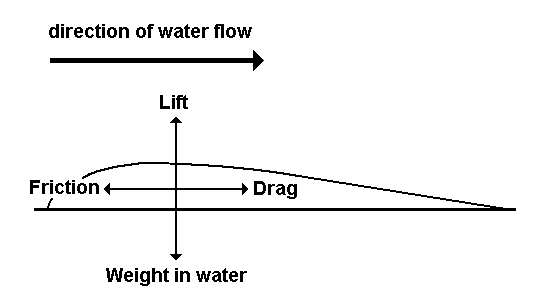
Buoyancy
The Problem
Exploiting the full depth of the water column from the top to the substratum with minimal energy costs requires regulation of altitude. The high density of water reduces the magnitude of the body support problem, but does not eliminate it. A typical mean density of a fish carcass is 1075 kg/m3, compared to FW at 1000 kg/m3 and SW at 1025 kg/m3. Achieving neutral buoyancy can minimize energy cost to remain in the surface photic zones, use currents and tidal stream transport, and improve maneuverability to hunt in 3-D space or to avoid predators. There are also disadvantages in being benthic, especially in current-swept habitats.
Mechanisms for generating lift
Hydrodynamic Lift
This is the most common method of supporting the weight of the fish in water, Wo. Hydrodynamic lift is used in all situations, alone or in conjunction with a hydrostatic buoyancy force. Hydrodynamic lift is rapid-responding to disturbances. Hydrodynamic lift is produced by propulsors. The cost of generating hydrodynamic lift increases as speed decreases.
Hydrostatic Lift
Hydrostatic lift is provided by inclusions with density lower than that of the water surrounding the fish.
|
Buoyancy saving (Kg/m3 of water displaced) |
||
|
Inclusion |
in freshwater |
in seawater |
|
Gas |
999 |
1025 |
|
Lipid |
83 - 144 |
109 - 170 |
|
Low density fluid |
none |
26 |
Gas Inclusion
Gas bladders are presumed to have arisen in bony fish as an evagination from the first embryonic gill pouch. There is much variation in the attachment to the gut and whether or not the air sacs are paired which leads some to argue that gas sacs have evolved several times.
Gut connections are: Physostomatous (soft-rayed fishes) - pneumatic duct present, Physoclistous (spiny-rayed fishes) - pneumatic duct absent, or Paraphysoclistous - pneumatic duct present in embryos. e.g. Myctophidae.
Gas gives the greatest amount of hydrostatic lift per unit volume but presents a number of problems:
These problems necessitate the use hydrodynamic lift to control posture in concert with hydrostatic forces.
To fill the gas bladder, physostomatous fish can gulp air, or burp gas. Physostomatous fish and physoclistous fish can fill the bladder via the gas-secreting rete.
Lipid Inclusions
Lipids are found in the liver in sharks, swimbladder wall - myctophids, skull, spinal bones, dermis - caster-oil fish, intermuscular sacs. Lipids are also energy sources.
|
Lipids: |
Density |
|
hydrocarbons ("squalene") |
860 kg/m3. |
|
wax esters |
860 kg/m3. |
|
diacyl glyceryl esters |
890 kg/m3. |
|
triglycerides |
920 kg/m3. |
Low Density Fluids/Tissues
Water content increases, decreasing the density of the body fluids and tissues. This is only possible for marine fish
Trade-off of various buoyancy mechanisms
Swimming speed
Hydrodynamic lift is more economical at higher swimming speeds. Hydrostatic lift is more economical at low swimming speeds, and gas inclusions are more economical than lipid inclusions.
Low density fluids are economical at very low speeds - indeed, the loss of muscle and skeletal tissue makes strong swimming impossible. These fish are mainly suction feeding ambushers.
Depth
The cost of gas secretion is approximately 2 ml. O2/kg.hr at 100 m depth and 35 ml. O2/kg.hr at 1,000 m. Therefore, gas inclusions become expensive at large depths. Gas inclusions are unstable in shallow water.
Flow Refuging
It is energetically very expensive to hold position relative to current-swept substrata by swimming against the flow. Currents are beneficial for food and transport. To obtain the advantages of currents without the disadvantages, fish typically refuge for the flow in low-flow adjacent to the high current areas. The ability to use flow refuges depends on the balance of forces – weight, lift, drag, and friction.

Weight = Wo
Friction = F = m (Wo - L)
Lift = L = 0.5.r .A.u2.CL
Drag = D = 0.5.r .A.u2.CD
F = D
2 Wo / r .A.u2 = CL + CD/m
To maximize the speed at which a fish is displaced: